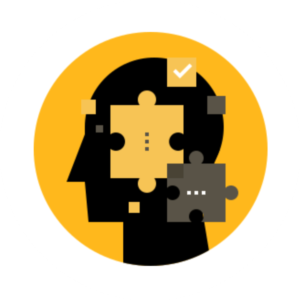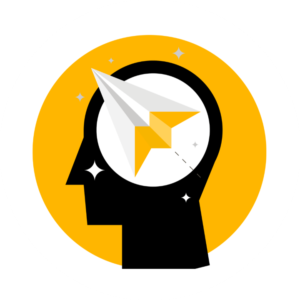List of contents
Project Overview
 About the project, Project duration, Goal, Challenge, My role
About the project, Project duration, Goal, Challenge, My role
Design Process
Solution
 Final Hi-fi design solution, Next Steps
Final Hi-fi design solution, Next Steps
Project overview
Client Industry
Accounting and Taxation Industry
Project duration
The rebranding of the existing website was completed in Q1 2023, after 12+ weeks of work beginning at the end of Q4 2022.
Platform
Responsive Website
Project Goal
To enhance the user experience of the Growth Team’s website through rebranding and redesign.
About this project
Equus Partners is a Melbourne-based business advisory that helps small businesses with accounting and taxation services. They had already established a brand bible and were rebranding to Growth Team when they approached us to revamp their website.
The goal of website redesigning was to stay true to the product while improving the user experience. To achieve this, research was conducted to understand the business needs and customers of Equus Partners.
My role
I contributed as a UX researcher in the early stages of the project, and then took on the role of lead UI designer as the project progressed.
The main areas of responsibility include:
- Managing sprint planning and weekly reviews.
- Conducting UX analysis, including flows and personas.
- Designing the responsive website, and branding.
- Prototyping basic flows and interactions.
- Handing over the website to front-end development.
Problem statement
“Small & medium businesses feel that they have limited knowledge and expertise to grow their business and reach their goals. They are faced with a lack of support from standard accounting advisories and are unsure what help they need or how to find the right services for their unique needs.
The challenge
To investigate the challenges and opportunities that small and medium-sized businesses (SMBs) face in order to identify how to optimize the Growth Team’s digital and physical touchpoints for sustainable and successful conversion of potential and existing clients.
The Growth Team aims to become a source of truth and a trusted advisor for small and medium-sized businesses (SMBs). By leveraging network referrals, a strong multi-channel presence, and raising awareness of the current and future challenges that SMBs face, it will be possible to achieve this.
For existing clients, the Growth Team wants to provide a one-stop shop for multiple business needs. One advisor should be assigned to work with the client throughout their growth journey to ensure transparent communication and seamless interactions with the wider team. This will build trust and provide a personalized experience for clients.
Design Process

Phase I - Discover
Desktop research
The top 3 reasons why small businesses (SMBs) fail are as below.
Absence of Leadership
Insufficient market research, marketing, or sales
Financial Illiteracy
Lack of financial understanding, including not having the necessary financial skills to manage the company or knowing how to fund company growth
Lack of Direction
Insufficient market research, marketing, or sales

Competitor analysis
A competitor analysis was conducted using 3 criteria: target audience, services, and type of content on their websites.
Testimonials and Case Studies
Social proofing (client reviews and case studies) can help build the trust and authority of the brand
CTAs that Convert
Relevant and clear call to action (CTAs) can help guide users to take the desired action, such as getting in contact or finding out more
Lead Magnets
Free content in exchange for contact details can help build a customer base and soft nurture leads
One-on-one interview
During the interview with 5 existing and 13 potential clients, the below key insights were gathered.
Trust Factor
Businesses value an advisory that builds trust
One-stop-shop
Businesses value an advisory that provides a range of services, such as accounting, marketing, and operations
Clarity
Businesses expect clear communication from their advisors, without confusing them with industry jargon

Phase II - Define
Affinity map and Empathy map
The discovery phase was a valuable first step, but we still needed to do more work to define the problem space and develop a solution.
The research data were synthesized using affinity maps and empathy maps to identify pain points and opportunities for personas, which led to the creation of journey maps.

Key insights on the pain points
Prospective clients
Staff need more engaging learning experiences and support from managers and colleagues to retain knowledge and improve performance. Current knowledge tools are not meeting their needs.
Existing clients
Managers are positive about their team and support system but want to improve the onboarding process to personalize and develop human connections.

User persona
Potential clients
A new staff member who is motivated by the positive team culture and buddy shifts, but feels overwhelmed by the onboarding process and wants to feel confident in the information she provides to students.

Existing clients
A manager motivated to create a supportive onboarding experience for new staff members, who are aware that the onboarding process can be overwhelming, wants to encourage them to learn about the resources and create a transparent feedback system.

Customer journey map
Potential clients
The user was initially overwhelmed by the induction day and the Notebook system. They felt stressed before each shift and frustrated that they could not resolve academic inquiries themselves. After almost 4 months, they are starting to feel more comfortable but still feel stressed when the system changes. They would like more feedback from management.

Existing clients
Manager delivers 3-hour presentation and 1-hour tour on MQ, The Notebook, employment basics, systems, and service areas. Introduces buddy shifts and assigns them. New staff find buddy shifts helpful, but not enough to learn from induction and onboarding. Need more specific feedback from managers to improve performance.


Phase III - Develop
How Might We
Three How Might We (HMW) questions were asked based on the research to help the users generate ideas. The questions were then analyzed to identify the most user-centric solution.
Prospective clients
How can we help small business owners find financial and business advice, and build trust with a business advisor?
Existing clients
How might we enhance awareness of Equus Partner’s services to other business owners and encourage current clients to refer their network to the company’s services beyond accounting and bookkeeping services?
Ideation
A 30-minute ideation session was held with 2 existing clients and 2 prospective clients. The agenda included an introduction to user personas and their journeys, how might we statements, the Crazy 6’s exercise, and concept creation. The objective of the session was to create solutions for personas by generating tangible features.

MVP Matrix
A Minimum Viable Product (MVP) matrix was created based on the generated ideas and concepts to analyze the most beneficial solutions for the personas.

Results-based fees
This feature would allow users to pay for services based on the results they achieve, rather than on a fixed fee.

Social ties
This feature would allow users to connect with other people who share their interests, and to get support and advice from them.
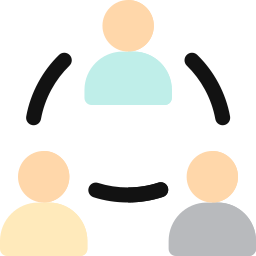
Referral reward
This feature would reward users for referring new customers to the service.

Community network
This feature would allow users to connect with other businesses in their industry, and to share resources and knowledge.
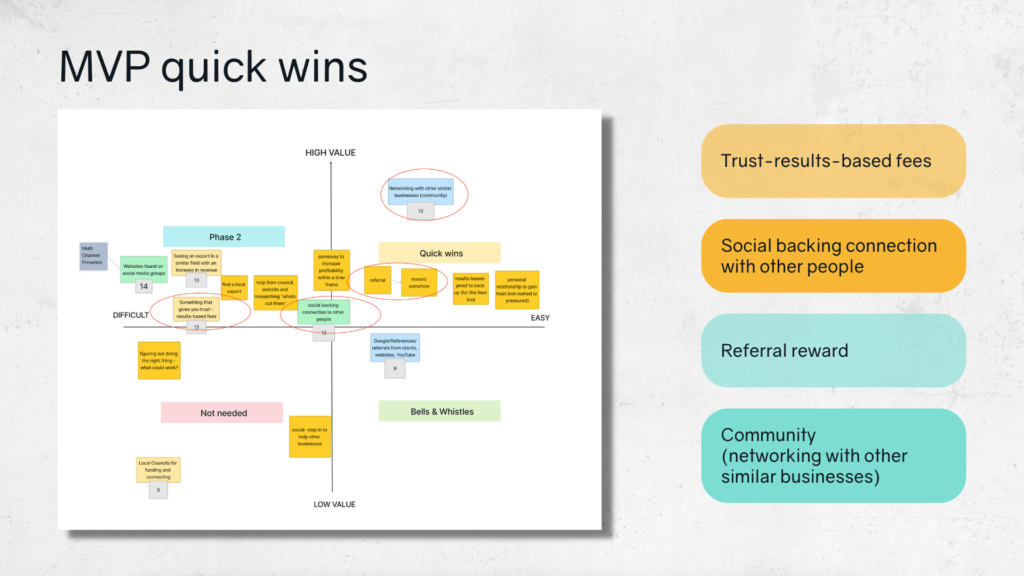
Service design Roadmap
A 30-minute ideation session was held with 2 existing clients and 2 prospective clients. The agenda included an introduction to user personas and their journeys, how might we statements, the Crazy 6’s exercise, and concept creation. The objective of the session was to create solutions for personas by generating tangible features.

Forecasting
The UX solutions were designed to seamlessly integrate and optimize the online touch points of a client’s journey.
A forecast was created to showcase the significance of five key initiatives that are backed by research. These initiatives include the below key initiatives to maximise the potential of the website.
SEO
This feature would allow users to pay for services based on the results they achieve, rather than on a fixed fee.
Lead generation
This feature would allow users to connect with other people who share their interests, and to get support and advice from them.
Referral
This feature would reward users for referring new customers to the service.
Community
This feature would allow users to connect with other businesses in their industry, and to share resources and knowledge.
Social proof
This feature leverages positive testimonials to create awareness, validation, and legitimacy of Growth teams offerings.
Search Engine Optimisation (SEO)
UX – Clear information structure, CTA buttons, optimized page title, appropriate headings, well-designed navigation, mobile-friendly interface.
SEO optimized website UX – Hierarchy, individual pages for each service, seamless mobile-friendly website, integrated SEO-optimized blogs and case studies, researched-backed CTA statements, linking video and other content.
SEO: Website loading speed, optimized code and content for search engines, link building.
SEO-optimized content: Relevant keywords, curated site content, quality blog content, optimizing existing content.

Lead generation
Lead generation strategies were used to evoke enthusiasm and inform the audience of what was expected of them. This was done by providing visitors with useful, free information. The strategies included exclusive offerings and glimpses of services, blog content, referral incentives, SEO, and video content.

Referral
Referrals are a powerful way to generate new business opportunities. Research shows that referrals account for 65% of new business opportunities, and referred buyers are more likely to make a purchase and become long-term customers. Users also value referrals, citing them as a core factor in their decision-making process.

Community
The Growth Team provides several benefits to both the team and its clients. For the team, the benefits include lower client acquisition costs, increased client retention, and a lower cost of service. For clients, the benefits include access to a business hub, support from other business owners, shared resources and contacts, access to special events, and the opportunity to learn about the suite of Growth Team services.
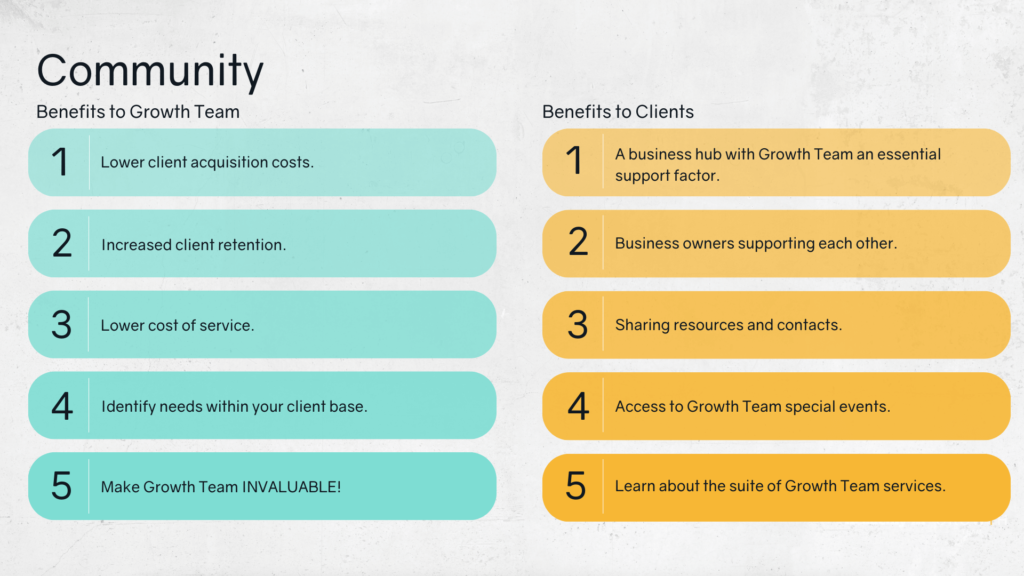
Social proof
92.4% of B2B buyers trust reviews. Growth teams leverage positive testimonials to create awareness and validation of their services. They collect reviews on trusted platforms and use them on digital and physical touchpoints. This builds authority and legitimacy for their offerings.
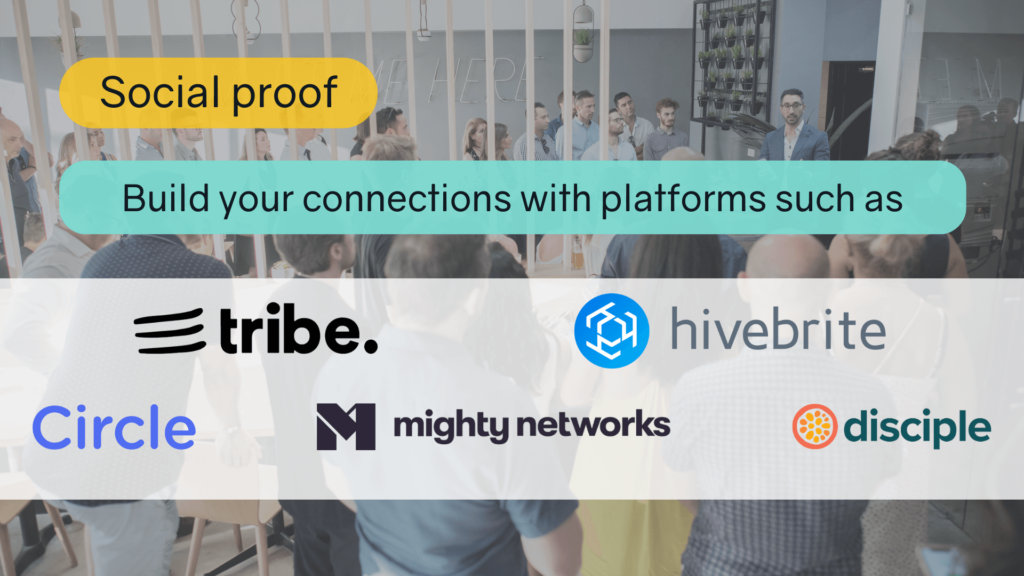
Storyboard
Prospective clients journey
The storyboard depicts the user journey from consulting the Growth Team to becoming a member of their community and earning rewards for referrals. The illustrations were created by visualising the concept, and the colors were carefully selected from Equus Partners’ brand bible to reflect the company’s branding


Phase IV - Deliver
An onboarding framework, a mentorship group service model, and a learning map were created.
User Flow
The highlight of the user flow is a gamification learning experience that includes live battle trivia, a treasure hunt journey, and scenario role-play. These features allow users to compete with each other, enhance their engagement with OneNote, and practice their skills.
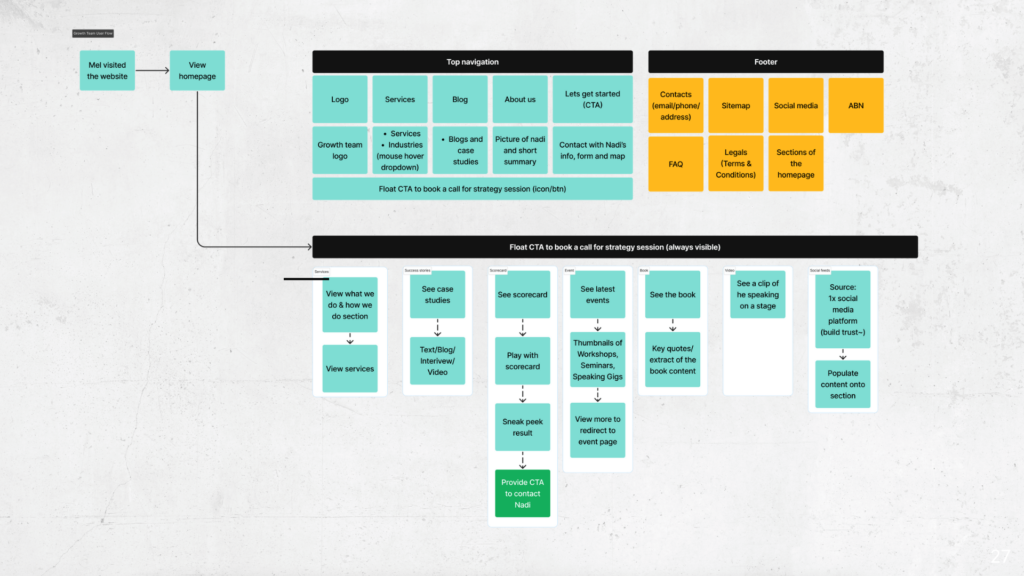
Low-fi Usability Testing
System usability scale results
The low-fi/mid-fi user testing of the UI design was conducted on 7 testers with a desirability rating of 6.3 out of 10.
Users feedback
- The readability size was not great and the home page was repetitive
- The home page needed to be broken up into sections to improve readability, and users made misclicks when navigating to the home screen.
Low-fi/Mid-fi improvements
- Used relevant font sizes to make it more readable
- Categorized the home page to improve navigation

Hi-fi Prototype - Usability Testing I
System usability scale results
The Hi-fi prototype was user tested with 5 testers and received a desirability rating of 8.25. The Hi-fi testing feedback suggests that the webpage needs improvement in the following areas.
Users feedback
- The user testing revealed that users needed an indication of what page they were on.
- Some buttons did not look consistent, and users wanted a home button as they struggled to find it just by using the logo.
- The overall design was considered professional and easy to navigate.
Hi-fi improvements
- Added a page title or breadcrumb trail to indicate what page the user is on.
- Made the buttons more consistent in size, color, and style to help users identify them more easily.
- Added a home button to the website to make it easier for users to return to the homepage.

Hi-fi Prototype - Usability Testing II
System usability scale results
The high-fidelity prototype was refined through an iterative design process that incorporated user testing feedback. The final design solution was tested with 6 testers and is rated 8.8 on the desirability scale, an improvement of 0.55 points from the previous version.
Hi-fi user feedback
- The user testing revealed that the website was very intuitive and easy to use.
- The copy on the website was clear and made sense, and users were able to easily find the information they were looking for.
- The overall design was considered to be very user-friendly.

Responsive Mobile version
After finalizing the high-fidelity website prototype version, a responsive mobile version was created. The mobile mock-up of the website was designed for future testing. This implementation uses a responsive web design, which changes the appearance of the pages to accommodate large fingers and increase accessibility. An easy navigation bar was also implemented.

Solution
Final Design Solution
Organizational goals
The solution helped the organization achieve its strategic goals: website traffic, leads, trust. Strategic placement of testimonials, community section, referral reward program. Testimonials build trust, community connects, referral rewards incentivize.
Solution
The final solution is designed to provide a long-lasting experience on the website for potential clients. This is achieved through the strategic placement of testimonials, a community section for clients, and a referral reward program. Testimonials help to build trust with potential clients by providing social proof that other people have had positive experiences with the organization. The community section allows potential clients to connect and share their experiences with the organization. The referral reward program incentivizes potential clients to refer their friends and colleagues to the organization.
Additionally, the website with optimized content, calls to action (CTAs), and imagery would garner relevant leads. Optimized content is content that is well-written and informative. CTAs are prompts that encourage users to take a desired action, such as signing up for a newsletter or downloading a white paper. Imagery is visual content that can be used to capture attention and communicate a message.
Benefits
The service design roadmap would build trust and confidence in the Growth Team for potential clients. The service design roadmap is a document that outlines the organization’s plans for improving the customer experience. It shows potential clients that the organization is committed to providing a good customer experience.
Hi-fi Prototype Screens
Home landing

Services


Industry

About us

Blogs


Next steps
User testing – The website would be tested with users to ensure that it is easy to use and understand
Mobile-friendly SEO – The website would be optimised for mobile devices so that it can be easily accessible by users on their phones and tablets.
Company testimonials – More testimonials from clients and customers would be gathered to showcase the positive experiences they have had with the organization.
Strong partnerships – To share resources and expertise strong partnerships would be formed with other organizations in the industry.
I hope you enjoyed my project case study. Thanks for taking the time to read it!



